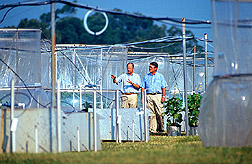Ozone Puts New Wrinkle in CO2 Yield Projection
|
|
 Plant physiologist Joe Miller (left) and plant pathologist Allen Heagle discuss an experiment on the effects of elevated carbon dioxide and ozone on soybeans. (K7443-17) |
Concentrations of carbon dioxide in our air are on the rise. During this century, CO2 levels are expected to double what they were in preindustrial times.
Rising CO2 stimulates growth and increases yield in a variety of food and fiber crops. But will yields surge enough to feed the world's population of 9 billion expected by 2050? To find out, scientists have developed computer models for each of the major crops—mainly grains. "We use models to project the effects of both rising CO2 and projected climate changes on world food supply," says Cynthia Rosenzweig. She heads the project at NASA's Goddard Institute for Space Studies at Columbia University in New York City. New ARS research suggests that the models may often overestimate how much CO2 enrichment will stimulate growth. The scientists are proposing that another gas be included in the models: the air pollutant ozone. This oxidizing agent damages plant tissue and decreases crop yield. "But studies to measure the positive effects of CO2 and the negative effects of ground-level ozone on crop yield have traditionally looked at each gas separately," says plant physiologist Joseph E. Miller. He is the head of ARS' Air Quality-Plant Growth and Development Unit in Raleigh, North Carolina. Miller and colleagues Allen S. Heagle, Edwin L. Fiscus, and Fitzgerald L. Booker have been combining the two gases in various concentrations on several crops throughout the growing season. The results suggest that much of the CO2 yield boost reported by other researchers may not be true increases but rather a case of CO2 preventing losses caused by ozone—at least in ozone-sensitive crops. "When ozone stress is low, increasing CO2 concentration does not always stimulate plant growth a lot," says Heagle. Extra CO2 by itself will cause some growth stimulation because the plants have more "food" for photosynthesis. So far, the researchers have seen this interaction in field tests of soybeans, winter wheat, rice, and cotton and in greenhouse tests of snap bean and white clover—a forage crop. Each crop or variety responds to a greater or lesser degree, depending on its sensitivity to each gas, but the trend is always the same. Soybeans are quite sensitive to ozone, as is cotton, Miller notes. And some varieties of wheat and rice also suffer damage and yield loss under high ozone. Other researchers have reported a similar interaction between CO2 and water stress. Some crops don't respond as much to high CO2 when they get ample water throughout the growing season, says Heagle. He explains that extra CO2 partially closes the leaf pores, or stomates, through which plants exchange gases. This reduces the ozone that gets in and the water vapor that gets out. "So if plants are under ozone or water stress, you'll get a greater response to CO2 enrichment. The more ozone stress, the more damage prevention and the greater the apparent growth stimulation." "It doesn't seem to matter what ozone damage we measure—photosynthesis, foliar injury, or yield—all are prevented by CO2," says Heagle. "The greater the ozone stress, the greater the amount of CO2 that will be needed to prevent it, and it's not necessarily a linear relationship." Why do some experiments show greater response to elevated CO2 than others? "It may be due to unrecognized differences in water or ozone stress among different studies," says Miller. The Raleigh findings have CO2 researcher Bruce A. Kimball scratching his head. Kimball, who heads ARS' Environmental and Plant Dynamics Research Unit in Phoenix, Arizona, says that many of the studies reporting yield increases from CO2 enrichment were probably performed at low ozone levels. "I think the CO2 stimulation [the Raleigh researchers] are getting in low ozone is generally lower than what is reported in the literature," says Kimball. Steven J. Britz, who heads the Climate Stress Laboratory in Beltsville, Maryland, adds, "The Raleigh experiments are a good example that the field of CO2 response is still very much in development."—By Judy McBride, Agricultural Research Service Information Staff. This research is part of Global Change, an ARS National Program (#204) described on the World Wide Web at http://www.nps.ars.usda.gov/programs/nrsas.htm. Joseph E. Miller and Allen S. Heagle are in the USDA-ARS Air Quality-Plant Growth and Development Research Unit, 3908 Inwood Rd., Raleigh, NC 27603; phone (919) 515-3312, fax (919) 515-3593. |
|
"Ozone Puts New Wrinkle in CO2 Yield Projection" was published in the April 2000 issue of Agricultural Research magazine.
|
|






